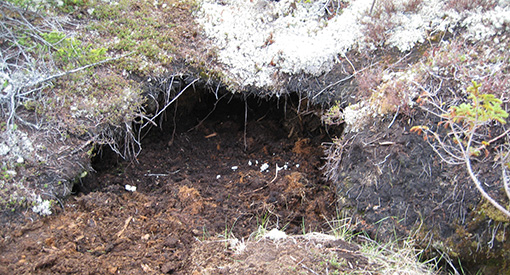Dr. Doug Clark on dens
Wapusk National Park
As one of the world’s largest maternity denning areas for polar bears, Wapusk National Park makes for a fascinating place to study these majestic creatures.
One of the leaders in research is Dr. Doug Clark, an Associate Professor at the University of Saskatchewan’s School of Environment and Sustainability and former park warden at Wapusk.
Dr. Clark began studying the area as a master’s student in the early 1990s, before the land was designated as a national park. Early on in his research, he spent years poring over satellite images and flying over the park to determine where bears denned, but was eager to delve deeper. Dr. Clark sought to map out the den sites while understanding how bears chose particular sites.

Working with Dr. Ian Stirling of the Canadian Wildlife Service, Dr. Clark got an up-close look at the dens, crawling into and measuring 48 polar bear dens over two seasons. The two worked out a system for establishing if a den was safe to enter.
“Only one was occupied at the time that we entered it,” Dr. Clark recalled, explaining that he and Dr. Stirling ran as fast as they could upon that realization, impressively traversing semi-liquid peat, along the lakeshore. Normally, people would sink into the peat quite quickly.
Despite the danger associated with acquiring the knowledge, the research led to greater understanding of why dens are vital to the polar bear population in the warmer months. Among the benefits are that the dens are dark, quiet, bug-free and a cool, consistent temperature. Without them, bears would be exposed to temperatures reaching 30 degrees Celsius and a “horrendous” insect population that would require them to expend energy that they are unable to spare.
“You can tell why it works for a female polar bear to be in those spaces at that time of year,” Dr. Clark said.
Dr. Clark relayed other fascinating facts regarding dens from other research, including that dens have been reused for more than 250 years, not necessarily annually or by the same bear.
“A den is an incredibly intimate space for a bear, and subsequent research has shown that it chases them off if you handle bears in and around the den for research,” he also noted.
Some areas of Wapusk are highly concentrated with dens, primarily on the banks of the park’s rivers and lakes. The bears tunnel in the dens near spruce trees, with the roots helping to stabilize the dens.
“It’s a special part of the world for bears for a reason, and I think a big part of that is the denning habitat,” Dr. Clark said.- Date modified :